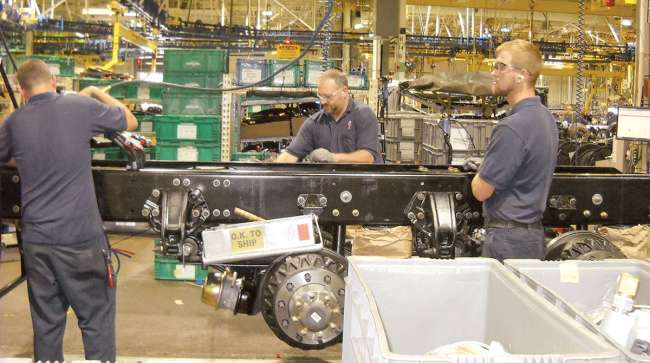Staff Reporter
Class 8 Truck Orders Fall 12% in August

[Stay on top of transportation news: Get TTNews in your inbox.]
North American Class 8 orders ended a three-month streak of positive year-over-year growth by falling 12% in August, according to ACT Research.
ACT preliminary data showed orders fell to 19,000 units from 21,600 during the year-ago period.
The report did note that despite the decline it was still the best month since February. It also noted continued economic strength and seasonal adjustments have kept orders on trend.
Orders did increase 18.8% from the previous month, which hit 16,000 units.
[August Preliminary State of the Industry: Classes 5-8 Vehicles Update] - August class 8 truck orders the best month since February at 19,000 units.
Get the update ➡️https://t.co/uQ0BEcVkSx#truck #semitruck #trucking #transportation, #Class8, #ACT, #ACTResearch pic.twitter.com/xAuRkgimmC — ACT Research (@actresearch) September 5, 2023
“As represented by seasonal factors, the industry remains at that time of the year when expectations for order activity are low, as most of the current year’s orders have been booked and out-year build plans are only starting to open,” said Kenny Vieth, president and senior analyst at ACT. “For Class 8, August is the last month of ‘weak order season,’ the four-month period that begins in May. Adding to downward pressure, the 2023 build plan has been essentially filled since the end of Q1.”
FTR Transportation Intelligence reported orders decreased 28% year-over-year to 15,400 units from 21,400. But the economic and freight forecasting firm warned the comparison is a bit deceptive since results were exceptionally strong last year. This time last year marked the beginning of the run-up in order activity that continued through November.
“As build slots start to open for 2024 production, fleets are starting to place orders on the books,” said FTR Chairman Eric Starks. “However, much of the ordering for 2024 has yet to be seen and typically will not show up until September or October. Despite rising order activity, the year-over-year comparisons will look horrible through November due to record order activity in the second half of 2022.”
FTR also noted in the report that order activity continues to be below replacement levels. It also found that Class 8 orders for the previous 12 months have equaled 294,000 units.

Starks
“The actual unit order levels will be more significant in the near-term than the year-over-year change in analyzing the strength of the market,” Starks said. “Even though order activity is still below replacement demand, a key takeaway from the August data is that fleets are not shying away from ordering new equipment, which is a good sign for the second half of the year.”
The Environmental Protection Agency has proposed what it called the most ambitious pollution standards ever for cars and trucks. The Greenhouse Gas Emissions Standards for Heavy-Duty Vehicles — Phase 3 proposes stringent standards to reduce greenhouse gas emissions from heavy-duty vehicles beginning with model year 2027. The California Air Resources Board and other state agencies have also proposed their own rules.
“It’s interesting times because next year, of course, we have the wave of greenhouse gas regulations coming into effect,” said Kyle Treadway, president of Kenworth Sales Co. “It’s new rules having to balance zero-emission vehicles and diesel vehicles. So the ordering process, we’re, as an industry, inventing it as we go. Yes, we’re used to allocation. We’ve been on allocation systems for the last few years, but it never gets any easier.”
Treadway noted these regulations have made it more difficult for truck manufacturers to allocate resources since they have to figure out what to prioritize in terms of building more electric or building more diesel trucks.
“We have CARB regulations, which are on a different time frame than EPA regulations,” Treadway said. “And so, we have to be very cautious, as an industry, of where these vehicles end up being. To certify compliance, it now means we have to, as the delivery arm for the vehicle sale, prove that these vehicles are going into certain states and meeting whatever their requirement is, whether they’re a CARB state or not. So, it complicates the delivery process.”
Want more news? Listen to today's daily briefing above or go here for more info
Treadway has started to map out build slots and the allocation process for the first half of next year. He hasn’t yet added end consumers on specific slots since there are still some unknowns about next year to figure out, like pricing. He is trying to ensure he has as many answers as possible for customers when it is time to accept customer orders.
“We’re just in the throes right now of opening up the order boards and doing the allocation process,” Treadway said. “We don’t have end user names on specific slots yet. We don’t have pricing yet. We’re still just trying to wind things up so that when it is time to accept customer orders, we have answers to all their questions or as many of them as we can.”




